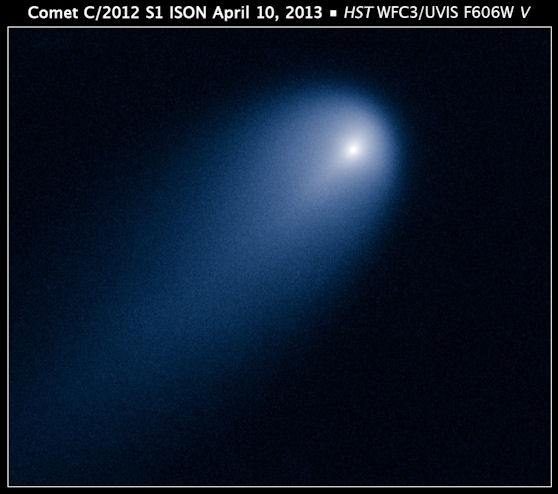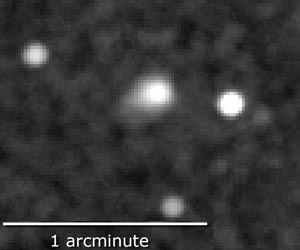
Home |
Learning Astronomy |
Astronomy Software |
Links |
Amateur Astronomy Projects |
Books
Solar System Exploration |
Pluto |
Space Telescopes |
Space Stations |
Space Tourism |
Earth |
Meteorology |
The Milky Way
Catalogues and Pictures |
Telescopes |
Videos |
Places To Visit |
My Projects
2012 and Planet X |
Aliens & UFO |
Astronomy & The Bible |
News |
Contact
Comet ISON aka C/2012 S1

A new picture of Comet ISON taken by the Hubble Space Telescope on 2013-04-10
Comet ISON is a new gigantic comet that is currently approaching Earth. The ISON comet, which is expected to become brighter than the full moon, will be visible to the naked eye by late 2013.
In September 2012, the Russian astronomers Vitaly Nevsky and Artyom Novichonok spotted what appeared to be a comet in images taken by a telescope that is part of the worldwide International Scientific Optical Network, or ISON, from which the object draws its name.
The astronomers say that given the comet's unique orbit, its origin may be the Oort Cloud, a cluster of frozen rocks and ices surrounding the solar system, located almost a light-year from the Sun. The Oort Cloud is an extensive system that extends from around a thousand times the distance of the Earth to the Sun to around 100,000-200,000 times this distance. If you imagine a model of the Solar System whereby the Sun's a football in the centre of a football pitch and the Earth is on the perimeter, then this comet has come effectively from Australia. That's the scale of things.
The ISON comet never plunged into the inner solar system, and its surface darkened because of the impact of galactic particles. At the same time, the comet avoided being damaged by the so-called solar wind, which is not the case for the Moon, for example.
Thus far, Comet ISON has only been visible through powerful telescopes. In November 2013, heat from the sun will vaporize ices in the comet's body, creating what could be a spectacular tail that will be visible in Earth's night sky without telescopes or even binoculars from about October 2013 through January 2014.
Another scenario is that Comet ISON could break apart as it nears the sun, failing to produce a tail of ice particles by the end of November. In December, the comet will be growing dimmer, but, assuming it is intact, it will be visible from both hemispheres of Earth. January 2014 may see a meteor shower produced by streams of debris from the ISON comet.
Sources:
2013 Jan 14 Russian astronomers discover new huge comet
2013 Jan 07 Celestial flybys set to thrill
Like all comets, ISON is a clump of frozen gases mixed with dust. Often described as "dirty snowballs," comets emit gas and dust whenever they venture near enough to the sun that the icy material transforms from a solid to gas, a process called sublimation. Jets powered by sublimating ice also release dust, which reflects sunlight and brightens the comet.
Typically, a comet's water content remains frozen until it comes within about three times Earth's distance to the sun.
Based on ISON's orbit, astronomers think the comet is making its first-ever trip through the inner solar system. Before beginning its long fall toward the sun, the comet resided in the Oort comet cloud, a vast shell of perhaps a trillion icy bodies that extends from the outer reaches of the planetary system to about a third of the distance to the star nearest the sun.
Formally designated C/2012 S1 (ISON), the comet was discovered on Sept. 21, 2012, by Russian astronomers Vitali Nevski and Artyom Novichonok using a telescope of the International Scientific Optical Network located near Kislovodsk.
The first of several intriguing observing opportunities occurs on Oct. 1, when the inbound comet passes about 6.7 million miles (10.8 million km) from Mars.
"During this close encounter, comet ISON may be observable to NASA and ESA spacecraft now working at Mars," said Michael Kelley, an astronomer at UMCP and also a Swift and CIOC team member. "Personally, I'm hoping we'll see a dramatic postcard image taken by NASA's latest Mars explorer, the Curiosity rover."
Fifty-eight days later, on Nov. 28, ISON will make a sweltering passage around the sun. The comet will approach within about 730,000 miles (1.2 million km) of its visible surface, which classifies ISON as a sungrazing comet. In late November, its icy material will furiously sublimate and release torrents of dust as the surface erodes under the sun's fierce heat, all as sun-monitoring satellites look on. Around this time, the comet may become bright enough to glimpse just by holding up a hand to block the sun's glare.
Sungrazing comets often shed large fragments or even completely disrupt following close encounters with the sun, but for ISON neither fate is a forgone conclusion.
"We estimate that as much as 10 percent of the comet's diameter may erode away, but this probably won't devastate it," explained Knight. Nearly all of the energy reaching the comet acts to sublimate its ice, an evaporative process that cools the comet's surface and keeps it from reaching extreme temperatures despite its proximity to the sun.
Following ISON's solar encounter, the comet will depart the sun and move toward Earth, appearing in evening twilight through December. It will swing past Earth on Dec. 26, approaching within 39.9 million miles (64.2 million km) or about 167 times farther than the moon.
Whether we'll look back on ISON as a "comet of the century" or as an overhyped cosmic dud remains to be seen, but astronomers are planning to learn the most they can about this unusual visitor no matter what happens.
Sources:
2013 Apr 01 NASA's Swift Sizes Up Comet ISON
For more information:
C/2012 S1 (ISON) - Cometography.com
NASA's Comet ISON Observing Campaign (CIOC)

NASA's Swift imaged comet ISON (center) on 2013-01-30
NEWS & SOURCES
2013 Apr 24 Hubble Sees Comet ISON
2013 Apr 19 Comet ISON Meteor Shower Jan 12, 2014 ???
2013 Apr 01 NASA's Swift Sizes Up Comet ISON
2013 Jan 14 Russian astronomers discover new huge comet
2013 Jan 07 Celestial flybys set to thrill
© 2006 - 2015 Nigel Romany
|